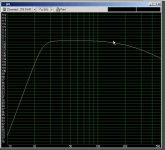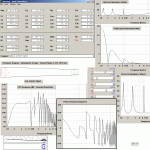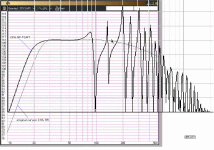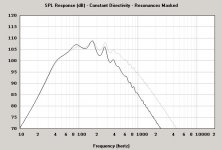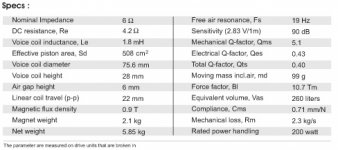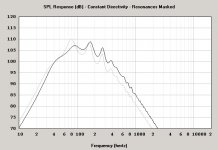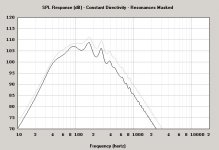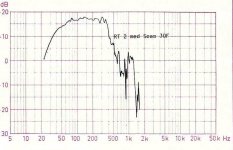jbell, that really looked interresting in deed.
But looking at the group delay plot, well.. it looks a bit "dramatic" how would this really sound??
But in terms of sheer output and extension vs cone excursion, it looks very good in deed!
Tried the same sim with the peerles SLS woofer, and that was all over the place with wild dips and peaks! 🙁
And regarding unloading of woofers below system resonance, i guess the trick is to build a system with low enough resonance! 🙂
I did a BR calculation for the Perless SLS, and sure enough, at a certain frequency at a certain power level, cone ecursion would just zoom off in to sky. But as this only happened at sub 20 Hz frequencies, I guess it would matter too much in real life! 🙂
Worst case, one could throw in a subsonic filter..
greater Xmax = greater Distortion? I wouldn't say that this is a given, but building a good driver that can deliver high Xmax AND low distortion comparable to a lower Xmax driver, that is perhaps another story.
But looking at the group delay plot, well.. it looks a bit "dramatic" how would this really sound??
But in terms of sheer output and extension vs cone excursion, it looks very good in deed!
Tried the same sim with the peerles SLS woofer, and that was all over the place with wild dips and peaks! 🙁
And regarding unloading of woofers below system resonance, i guess the trick is to build a system with low enough resonance! 🙂
I did a BR calculation for the Perless SLS, and sure enough, at a certain frequency at a certain power level, cone ecursion would just zoom off in to sky. But as this only happened at sub 20 Hz frequencies, I guess it would matter too much in real life! 🙂
Worst case, one could throw in a subsonic filter..
greater Xmax = greater Distortion? I wouldn't say that this is a given, but building a good driver that can deliver high Xmax AND low distortion comparable to a lower Xmax driver, that is perhaps another story.
Elbert said:
And regarding unloading of woofers below system resonance, i guess the trick is to build a system with low enough resonance!
With a 0.707 Qtc sealed rear chamber the driver never unloads, though of course it can be overheated to excessive thermal power compression/destruction, so using an Fs, Qts to fit the max Vb the horn allows seems the best compromise, but it appears that in 1pi space this horn is going to need considerable EQ to be tonally flat to its theoretical ~42 Hz (IIRC) sealed cab limit, i.e. a decent mid-bass horn, but not a bass 'shaker'.
If you can increase the rear chamber Vb, then lower Fs, higher Xmax drivers to go lower is an option, but all things considered, optimizing the RT-2 and adding 'sub' TL's, tapped horns or large EBS vented alignments tuned <20 Hz is what's required for high SQ to the limits of audibility combined with plenty of power to get the desired tactile feel of a live event.
GM
Hi GM,
Yes looks like with all the EQ hammering required to tame the horn, there is not that much benefit left afterward compared to say a BR enclosure..
Yes looks like with all the EQ hammering required to tame the horn, there is not that much benefit left afterward compared to say a BR enclosure..
Looking at some alternative solutions...
Enclosed is a frequency plot done with WinISD with a Peerless SLS 12 in a 230 l vented cabinet. (about the same volume as the RT-2 horn)
http://www.mamut.net/dynabel/subdet329.htm
At near maximum linear excursion, the plot shows a flat response down to a -3 dB at 23 Hz
I guess a horn would have to be pretty big to do the same..
Of course a horn might play 20-30 dB louder, but i guess 110 dB will be acceptable for domestic use anyway.. 🙂
I've read that the SLS woofers are only suited for closed box, but the data sheet states that extended response can be achieved in a vented design of 55-75 L..
Again, the sim I did was for an enclosure significantly larger than that.. Am I missing something out here, or might this driver actually work as well as it looks in such a very large BR enclosure??
Enclosed is a frequency plot done with WinISD with a Peerless SLS 12 in a 230 l vented cabinet. (about the same volume as the RT-2 horn)
http://www.mamut.net/dynabel/subdet329.htm
At near maximum linear excursion, the plot shows a flat response down to a -3 dB at 23 Hz
I guess a horn would have to be pretty big to do the same..
Of course a horn might play 20-30 dB louder, but i guess 110 dB will be acceptable for domestic use anyway.. 🙂
I've read that the SLS woofers are only suited for closed box, but the data sheet states that extended response can be achieved in a vented design of 55-75 L..
Again, the sim I did was for an enclosure significantly larger than that.. Am I missing something out here, or might this driver actually work as well as it looks in such a very large BR enclosure??
Attachments
Elbert said:
I've read that the SLS woofers are only suited for closed box, but the data sheet states that extended response can be achieved in a vented design of 55-75 L..
Again, the sim I did was for an enclosure significantly larger than that.. Am I missing something out here, or might this driver actually work as well as it looks in such a very large BR enclosure??
Carefull, there a risk of sloppy bass doing that
Its true, many genuine sub drivers have high Qts, indicating the use of closed box, yet they are widely used in BR...well, I honestly dont understand it really, but it could be part of a commercial interest making it look better in BR
Sloppy bass...that doesn't sound like a nice thing....
To me, the highly subjective term "sloppy" would indicate uncontrolled cone movement of some sort, perhaps the sort of result one gets when an enclosure stops loading the driver acoustically below the resonance frequency?
Perhaps the reason that some drivers are not recommended for BR enclosure is that the enclosure then needs to be very large for the system to work properly?
To me, the highly subjective term "sloppy" would indicate uncontrolled cone movement of some sort, perhaps the sort of result one gets when an enclosure stops loading the driver acoustically below the resonance frequency?
Perhaps the reason that some drivers are not recommended for BR enclosure is that the enclosure then needs to be very large for the system to work properly?
Well, its theoretical as I dont know any of these woofers, in which case I prefer follow the rules
But I kind of look at it like this
A small woofer may not present any poblem doing like you suggest
But a big woofer goes much lower, where there are higeher demands fore absolute control
Further a closed design rolls of very gradually and controlled, and due to that it may not present so much of a problem playing a bit of the lows
A BR on the other hand is going on at full blast, which is a whole different situation
Actually you will often see that the best woofers suited fore BR isnt actually going much lower than a closed, due to low Qts
In between theres a lot of good woofers that will do both, where the BR will do a little better in a small area, but the deepest lows are the same fore both closed and BR, and even sometimes a closed go deeper, only with less output
In these times it seems like its only possible to get really low with high Qts sub drivers in BR...I think its a compromise, and may be one reason why so many people experience that a sub is best fore films, and less good fore music
And theres room gain too, which many seem to forget
Its possible to design a sub driver suited fore music going really low, without the use of very heavy cones and huge stiff surrounds...but it wouldnt be good at very high SPL, which seems to interest most people, so the market may be too small
Well, SBAcoustic seems to be going in the right direction
But mostly it all begins with looking at the compromices on hand...seems we cant have it all in one
Oh yes, I have always heard that the best sub is one you dont hear, and its main feature is improvement of the soundstage, which has nothing to do with playing loud...probably many people will be very dissapointed with that
But I kind of look at it like this
A small woofer may not present any poblem doing like you suggest
But a big woofer goes much lower, where there are higeher demands fore absolute control
Further a closed design rolls of very gradually and controlled, and due to that it may not present so much of a problem playing a bit of the lows
A BR on the other hand is going on at full blast, which is a whole different situation
Actually you will often see that the best woofers suited fore BR isnt actually going much lower than a closed, due to low Qts
In between theres a lot of good woofers that will do both, where the BR will do a little better in a small area, but the deepest lows are the same fore both closed and BR, and even sometimes a closed go deeper, only with less output
In these times it seems like its only possible to get really low with high Qts sub drivers in BR...I think its a compromise, and may be one reason why so many people experience that a sub is best fore films, and less good fore music
And theres room gain too, which many seem to forget
Its possible to design a sub driver suited fore music going really low, without the use of very heavy cones and huge stiff surrounds...but it wouldnt be good at very high SPL, which seems to interest most people, so the market may be too small
Well, SBAcoustic seems to be going in the right direction
But mostly it all begins with looking at the compromices on hand...seems we cant have it all in one
Oh yes, I have always heard that the best sub is one you dont hear, and its main feature is improvement of the soundstage, which has nothing to do with playing loud...probably many people will be very dissapointed with that
I'll remind you what I said about my modified Tannoy B950.tinitus said:Oh yes, I have always heard that the best sub is one you dont hear, and its main feature is improvement of the soundstage, which has nothing to do with playing loud...probably many people will be very dissapointed with that
Listening the the TannoyB950 + Satellites Tannoy Reveal6D was good.
Listening to the Satellites on their own was poor. Switching them to wideband improved but nowhere near the support from the B950.
Listening to the B950 on it's own, there was almost no sound to be heard.
But, when both were on, it was very obvious that the bass was there.
BTW, the cross over was LP=150Hz 4pole and the HP was 80Hz 2pole + 150Hz 2pole.
… Enclosed is a frequency plot done with WinISD with a Peerless SLS 12 in a 230 l vented cabinet…I guess a horn would have to be pretty big to do the same...
… Enclosed is a frequency plot done with WinISD with a Peerless SLS 12 in a 230 l vented cabinet…I guess a horn would have to be pretty big to do the same...
Of course a horn might play 20-30 dB louder, but i guess 110 dB will be acceptable for domestic use anyway…I've read that the SLS woofers are only suited for closed box, but the data sheet states that extended response can be achieved in a vented design of 55-75 L…
Hi Elbert,
You are right a horn would be huge but not if a BP-TQWT, See picture 1(2).
Actually the 230 L BR box you mentioned can be compared to the about 215 L simulated BP-TQWT in picture 2(2) where the difference can be observed.
Note: A BP-TQWT is stuffed like an ordinary TQWT and the ripple over 90 Hz is negligible (IME) if simulated as can be seen using MJK:s TL programs with about 8 kg/m^3 stuffing density.
IME. A tapped horn with a series inductance or not/ BR-box has much lower SQ than a BP-TQWT that is FR QW extended, traded for BW from mid-bass efficiency.
IMO 110 dB is more SPL I heard in an ordinary living room that I could copy with.
b
1(2)
Attachments
Horns need to be big
a Labhorn is 600Litres and you need 6 of them for floor loading down to 27Hz.
a Labhorn is 600Litres and you need 6 of them for floor loading down to 27Hz.
wow.. that was interesting!
Looks like the classic transmission line to me! 🙂
Been a while since I've looked in to that by the way..
But heck, this thread is really starting to de-rail now..
Since I've been away from any proper audio-projects for a long time, I've decided that I'll go ahead and see what I can really get out of the horn.. If not for building the greatest subwoofer ever, then at least for the fun of some good old experimentation. I Guess that's where the word "hobby" comes back in.. 🙂
This also means I'll have to keep within certain economical constraints as I cant justify buying $$$ drivers just for the sake of experimentation...
So where to start?
Light cones.
The gamma driver recommended is certainly very light, and makes for a relatively smooth sim. The Seas is somewhat comparable, that too having a fairly, at least by current standards, ligh cone.
And the drivers origninally recommended were allso very light...
The challenge will be to find some candidate drivers in this category, new or second hand.
Any ideas are of course welcome.. 🙂
And to tie it all together...
http://www.diyaudio.com/forums/showthread.php?s=&threadid=100295&highlight=
Looks like the classic transmission line to me! 🙂
Been a while since I've looked in to that by the way..
But heck, this thread is really starting to de-rail now..

Since I've been away from any proper audio-projects for a long time, I've decided that I'll go ahead and see what I can really get out of the horn.. If not for building the greatest subwoofer ever, then at least for the fun of some good old experimentation. I Guess that's where the word "hobby" comes back in.. 🙂
This also means I'll have to keep within certain economical constraints as I cant justify buying $$$ drivers just for the sake of experimentation...
So where to start?
Light cones.
The gamma driver recommended is certainly very light, and makes for a relatively smooth sim. The Seas is somewhat comparable, that too having a fairly, at least by current standards, ligh cone.
And the drivers origninally recommended were allso very light...
The challenge will be to find some candidate drivers in this category, new or second hand.
Any ideas are of course welcome.. 🙂
And to tie it all together...
http://www.diyaudio.com/forums/showthread.php?s=&threadid=100295&highlight=
Looks like the classic transmission line to me!…
Yes, it’s very similar but there are a difference that makes it possible to acoustically filter out some of the speaker driver generated distortions that are not present in the input signal, especially in the upper bass. (80-160 Hz).
I’ve compared TQWT’s with BP-TQWT’s using the same drivers close to x-max and found that the sound is produced/heard differently: TQWT’s sums at far field while BP-TQWT’s always at a point in Nearfield = the port.
Of course there are TQWT’s where the port is very close to the driver entrance and if the driver generated buzz and rattle/ distortion is low its hard to hear any difference, but IME only expensive driver types with very stiff cones (aluminum) and large x-max works satisfactorily.
My surprising experience is that ordinary (inexpensive) stiff paper coned drivers in a BP-TQWT are if designed with care almost behave blameless near x-max but not in other BR type of boxes.
The speaker localization que(s) are IME heavily attenuated if a BP-TQWT equipped with a suitable placed port, if you compare the two types the advantage is easily recognized.
b
Back on track?
Interesting bjorno..
Had it not been for the fact that I'm "past the concept stage", BP-TQWT would have been something that I'd look more in to...
After some tweaking with the active X-over, EQ, and general levels, the Horn is starting to work really well..
Since its running with the SEAS woofer from the right speaker, tweaking and tuning is not optimal so to speak.
But the sound is now what I would best describe as dry, deep and tight..
Listening to some classic Motown tracks, the fender-bass with flat-wound strings, complete with "live" studio reverberation, it really shines!
So I've decided to try and find a suitable woofer and then perhaps build a sub-EQ to fine tune the horn electronically. With the 10 band parametric I have, there's really only the two, perhaps three lowest controlls of 31, 63, and 126 Hz that's usable.
After a heap of iterative hornresp sims, it is becomming evident that the selection of suitable drivers is very limited.
So far, the sim that gives the most promising result is actually the SEAS 33F-WB!
the gamma LA1231 is very close except for seeming to be a few dB below the seas at 35-45 Hz (not by much though)
The advantage of the gamma is that the response is smoother further up than the SEAS. This is probably due to the very low cone weight, all the sims I have doone seems to show a very strong correlation between cone weight and ripples in the response curve.
Enclosed is the plot for the SEAS driver with the gamma curve superimposed in grey.
The strength of the SEAS is that it has 2mm more of linear excursion over the gamma.
But the biggest drawback of the gamma is that the integrity of the data I have scraped together may be somewhat dubious and the fact that its origins and quality are a bit obscure...
So that leaves me searching for an extra SEAS 13" woofer (hard to come by as they went out of production in the mid 80's), or any modern equivalent....
The characteristics that seem to work is:
Very low moving mass; 20-40g
Very low Fs; around 25 Hz
Moderate BL; around 10 N/M
Xmax; 5-7 mm
Qes around 0.4
relatively high Vas 240 and up..
regrettably, very few modern drivers seem to resemble this...
any suggestions will of course be most welcome.. 🙂
Interesting bjorno..
Had it not been for the fact that I'm "past the concept stage", BP-TQWT would have been something that I'd look more in to...
After some tweaking with the active X-over, EQ, and general levels, the Horn is starting to work really well..
Since its running with the SEAS woofer from the right speaker, tweaking and tuning is not optimal so to speak.
But the sound is now what I would best describe as dry, deep and tight..
Listening to some classic Motown tracks, the fender-bass with flat-wound strings, complete with "live" studio reverberation, it really shines!
So I've decided to try and find a suitable woofer and then perhaps build a sub-EQ to fine tune the horn electronically. With the 10 band parametric I have, there's really only the two, perhaps three lowest controlls of 31, 63, and 126 Hz that's usable.
After a heap of iterative hornresp sims, it is becomming evident that the selection of suitable drivers is very limited.
So far, the sim that gives the most promising result is actually the SEAS 33F-WB!
the gamma LA1231 is very close except for seeming to be a few dB below the seas at 35-45 Hz (not by much though)
The advantage of the gamma is that the response is smoother further up than the SEAS. This is probably due to the very low cone weight, all the sims I have doone seems to show a very strong correlation between cone weight and ripples in the response curve.
Enclosed is the plot for the SEAS driver with the gamma curve superimposed in grey.
The strength of the SEAS is that it has 2mm more of linear excursion over the gamma.
But the biggest drawback of the gamma is that the integrity of the data I have scraped together may be somewhat dubious and the fact that its origins and quality are a bit obscure...
So that leaves me searching for an extra SEAS 13" woofer (hard to come by as they went out of production in the mid 80's), or any modern equivalent....
The characteristics that seem to work is:
Very low moving mass; 20-40g
Very low Fs; around 25 Hz
Moderate BL; around 10 N/M
Xmax; 5-7 mm
Qes around 0.4
relatively high Vas 240 and up..
regrettably, very few modern drivers seem to resemble this...
any suggestions will of course be most welcome.. 🙂
Attachments
Thanks for the suggestion tinitus!
Low frequency extension comes out significantly better than the SEAS 33F-WB.
But unfortunately, the heavy cone (I assume) causes a more ragged response which will probably make integration with the stereo speakers more challenging.. (?)
I've attached the response from this SB Acoustics driver superimposed in gray over the SEAS response..
The perfect driver would probably have the smoother response of the seas driver and the low end extension of the SB driver.
Low frequency extension comes out significantly better than the SEAS 33F-WB.
But unfortunately, the heavy cone (I assume) causes a more ragged response which will probably make integration with the stereo speakers more challenging.. (?)
I've attached the response from this SB Acoustics driver superimposed in gray over the SEAS response..
The perfect driver would probably have the smoother response of the seas driver and the low end extension of the SB driver.
Attachments
And following this up..
I modified the moving mass of the SB driver from 99 g to 35 and did a new sim.. And the result from that was in deed excellent looking..
A driver (if it existed or were even possible) with that response would certainly be worht trying.
Enclosed is the response superimposed in grey over the SEAS again.
I modified the moving mass of the SB driver from 99 g to 35 and did a new sim.. And the result from that was in deed excellent looking..
A driver (if it existed or were even possible) with that response would certainly be worht trying.
Enclosed is the response superimposed in grey over the SEAS again.
Attachments
The ragged response seems to be related to your design
Last time I suggested the Dayton RS270S, you disapproved because its only a 10"
I suggest you try to sim it anyway, cant hurt, and you might be surpriced
Which reminds me that you could also try the SBAcoustic 10"
Lighter cone than its 12" brother, all else mostly the same
Your design is from a time before Martin Kings software, which is supposed to be the only one to do the calculations correctly, so the design may even not be optimal with a 12", a different size may as well do it
You may also want to take a look at other Daytons
http://www.intertechnik.de/index.ht...IlM0Q=.html?basis=6175&detail=52595&suchwort=
Last time I suggested the Dayton RS270S, you disapproved because its only a 10"
I suggest you try to sim it anyway, cant hurt, and you might be surpriced
Which reminds me that you could also try the SBAcoustic 10"
Lighter cone than its 12" brother, all else mostly the same
Your design is from a time before Martin Kings software, which is supposed to be the only one to do the calculations correctly, so the design may even not be optimal with a 12", a different size may as well do it
You may also want to take a look at other Daytons
http://www.intertechnik.de/index.ht...IlM0Q=.html?basis=6175&detail=52595&suchwort=
Tried a sim with the last woofer you suggested.. but the result didn't look very promising...
untill I tried simulating with two! 🙂
it should be physically possible to cram in two 10" or 8" woofers in tandem by making an adaptor baffle fitting over the original 12" driver cut out.
Tried simularting some drivers in this configuration, and the reults so far look encouraging.. 🙂
untill I tried simulating with two! 🙂
it should be physically possible to cram in two 10" or 8" woofers in tandem by making an adaptor baffle fitting over the original 12" driver cut out.
Tried simularting some drivers in this configuration, and the reults so far look encouraging.. 🙂
- Status
- Not open for further replies.
- Home
- Loudspeakers
- Subwoofers
- RT-2 Horn sub, the result
